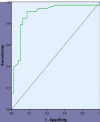Correlation of Mammography, Ultrasound and Sonoelastographic Findings With Histopathological Diagnosis in Breast Lesions
- PMID: 36628044
- PMCID: PMC9825104
- DOI: 10.7759/cureus.32318
Correlation of Mammography, Ultrasound and Sonoelastographic Findings With Histopathological Diagnosis in Breast Lesions
Abstract
Introduction Breast masses range from inflammatory and benign to malignant lesions, varying in different age groups and clinical presentations. Breast imaging techniques leading to prompt and specific diagnosis have been a lifesaver for millions around the globe saving them undue mental stress in inflammatory lesions and preventing early death in case of neoplasms. Here, we compare mammography, ultrasonography (US) and ultrasound elastography in the screening and diagnosis of breast lesions and the usefulness of strain ratio as a non-invasive tool in diagnosing breast malignancies. Aims and objectives Determining the characteristics of breast lesions on imaging by mammogram, ultrasonography, elastography, calculating strain ratio and correlating them with histopathology. To further estimate the advantages and limitations of one modality over the other in the evaluation of breast lesions. Methods The study was done over a duration of 18 months from November 2019 to June 2021 at JSS Medical College and Hospital, Mysuru. In this prospective study, 73 female patients with palpable breast lesions were evaluated using mammography, US and sonoelastography and were co-related with histopathological findings. Results This study has proved that the use of ultrasound elastography has higher sensitivity (91.67% with strain ratio kept at 3) in detecting malignant lesions when compared with x-ray mammography and ultrasonography having a sensitivity of 87.88% and 90.91%, respectively. Our study confirmed that there is a correlation between strain ratio and histopathological findings and that the strain ratio has high sensitivity in diagnosing and differentiating malignant breast lesions. Conclusions Mammography, US and sonoelastography when combined together are helpful in characterization and management of breast lesions. This helps to avoid unnecessary invasive interventions. The specificity of the study in detecting malignant lesions was comparable with that of histopathological analysis.
Keywords: bi-rads; breast cancer; elastography; mammography; shear-wave elastography; ultrasound.
Copyright © 2022, Thomas et al.
Conflict of interest statement
The authors have declared that no competing interests exist.
Figures






References
-
- Global cancer statistics 2020: GLOBOCAN estimates of incidence and mortality worldwide for 36 cancers in 185 countries. Sung H, Ferlay J, Siegel RL, Laversanne M, Soerjomataram I, Jemal A, Bray F. CA Cancer J Clin. 2021;71:209–249. - PubMed
-
- Ultrasound elastography improves differentiation between benign and malignant breast lumps using B-mode ultrasound and color Doppler. Elkharbotly A, Farouk HM. Egyptian J Radiol Nuclear Med. 2015;46:1231–1239.
-
- Supersonic shear imaging: a new technique for soft tissue elasticity mapping. Bercoff J, Tanter M, Fink M. IEEE Trans Ultrason Ferroelectr Freq Control. 2004;51:396–409. - PubMed
-
- Diagnosis of solid breast lesions by elastography 5-point score and strain ratio method. Zhao QL, Ruan LT, Zhang H, Yin YM, Duan SX. Eur J Radiol. 2012;81:3245–3249. - PubMed
-
- Ueno E, Iboraki P. European Congress of Radiology. Vienna: European Congress of Radiology; 2004. Clinical application of US elastography in the diagnosis of breast disease.
LinkOut - more resources
Full Text Sources
